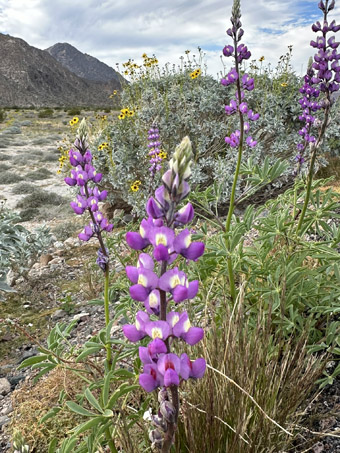BEE HIVE MAY 2024
San Felipe Desert
February 2024. Wow! We had an amazing botanical experience this February when we made a quick trip over the border via Hwy 5 through San Felipe and Los Algodones.
We first took this route back in January 2020, and on each of our subsequent trips (see links at the end of this post), the stark geology of the area between Laguna Chapala and San Felipe has almost always been the main attraction in this extremely arid desert region. The volcanic formations, wind-eroded boulders and variation in colors and textures have never failed to capture our attention.
But this year, it was a very different experience. Even though the Gulf coast desert is in the rain shadow of the Peninsular Ranges, it was obvious the area had received some of the moisture from a series of very wet storms that hit southern California in December 2023 and January 2024. The hillsides and flats were showing a dusting of green and what had so often been just rounded, gray mounds on the hillsides on past trips were actually starting to look like live plants with signs of some new growth.
At around Km 125 south of Puertecitos, near El Huerfanito, we came upon an incredible sight: desert flats on both sides of the highway covered with purple lupine and bright yellow brittlebush. There are few places to pull over along this stretch where the highway is built up on a dyke above the desert floor, but fortunately I found a pullout. When I opened the car door, I was hit by the heady aroma of an untold number of lupines wafting through the air. On our return trip five days later past the same spot, the plants were even more spectacular (top two photos below are from that day).
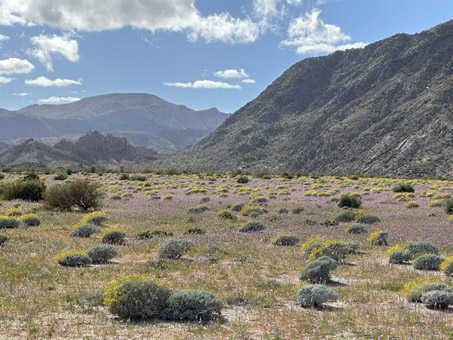
A superbloom of Brittlebush / Incienso (Encelia farinosa) and Arizona Lupine / Garbancillo del Desierto (Lupinus arizonicus). Smaller plants include Narrow-leaf Cryptantha / Nievitas (Johnstonella angustifolia)
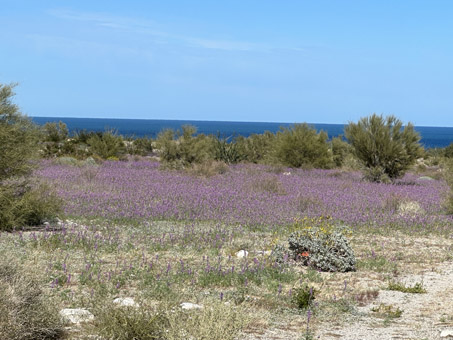
Just one of the many large patches of Lupine along this stretch of highway. This photo was taken on the E side of the highway where I pulled over, while the photo at right was on the other side of road.
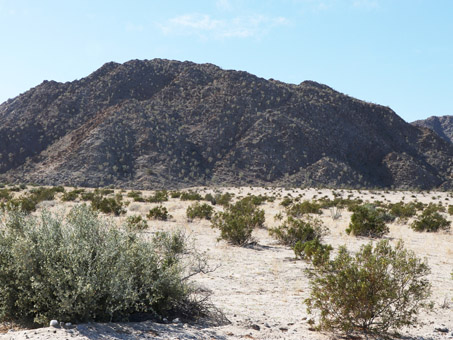
This is what the desert has looked like at the above location on practically all of our trips since January 2020.
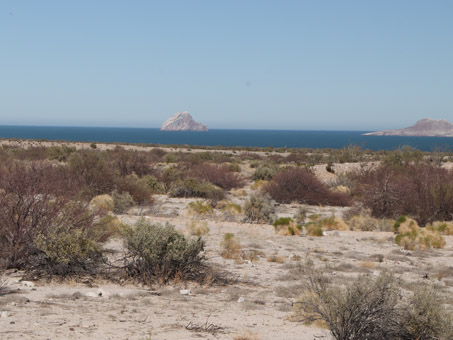
Again, what the desert flats have looked like at or very close to the same location as in the photo above. Quite a difference.
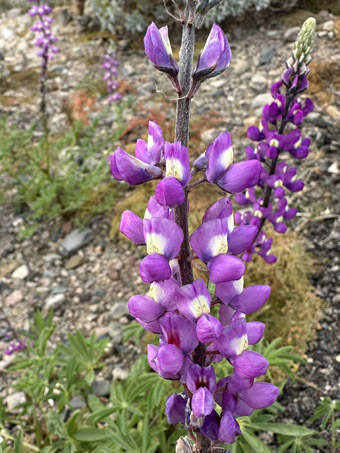
Arizona Lupine.
The drive north had been cool and dry, but on our third morning, as we left San Felipe heading towards Mexicali, we could see the edge of the cloud cover from a storm that was supposed to be petering out to the west off of San Diego and Ensenada. There was evidence along the roadsides that there had been some recent rain, and the giant salt flat known as Laguna Salada was a squishy mess with more than the usual amount of standing water along the highway edges.
The heavy clouds over the mountains were moving east as we moved north, and by the time we arrived in Los Algodones, just a block or two from the US border, it was heavily overcast. Shortly after we checked in at our hotel, the picture changed. What I thought at first was some loud construction work outside turned out to be the thunderclaps of a storm cell right overhead. The skies had opened and the rain pounded the hotel roof and patios for about 15 minutes before the booms and cracks of thunder and lightning finally had moved away to the east. So much for the local regional weather forecast that had predicted sunny skies.
A few days later, with all of our errands done in both the US and Los Algodones, we headed south again via San Felipe. There was still standing water and mud in many areas around town (it extended as far south as Guerrero Negro on the Pacific coast). Everything looked so much cleaner, brighter and greener. And then there were all the flowers...
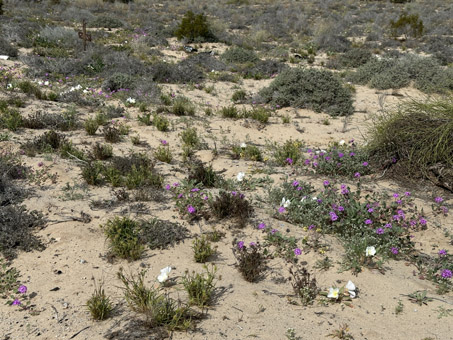
Dune Evening Primrose (Oenothera deltoides subsp. deltoides) was so abundant in the dunes just outside San Felipe that I mistook the white flowers for bits of trash trapped and fluttering in the greenery.
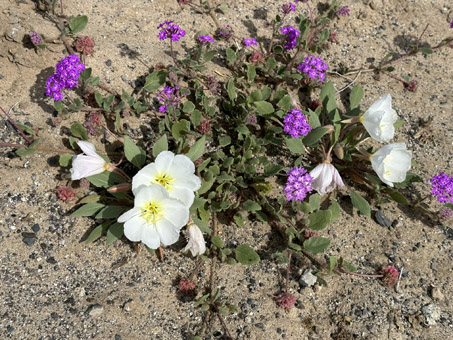
Dune Evening Primrose growing with Slender Sand Verbena (Abronia gracilis) near San Felipe. These were some of the first species with flowers, while many others were just sprouting or about to flower.
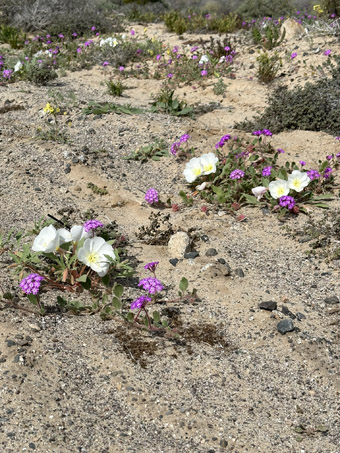
Other herbaceous species included Gulf Sandmat, Slender-leaf Cryptantha, and Pierson Sun Cup.
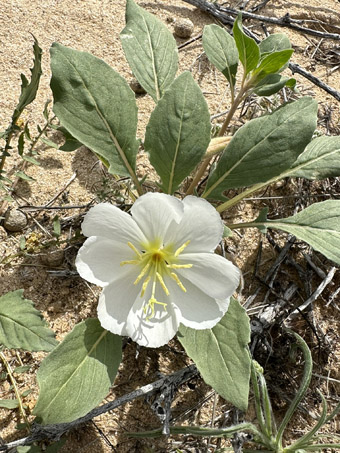
The flower of Dune Evening Primrose is large and showy with petals c. 15-35 mm L.
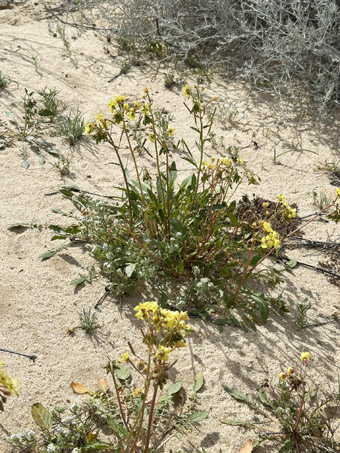
Pierson Sun Cup (Chylismia claviformis var. piersonii) was abundant.
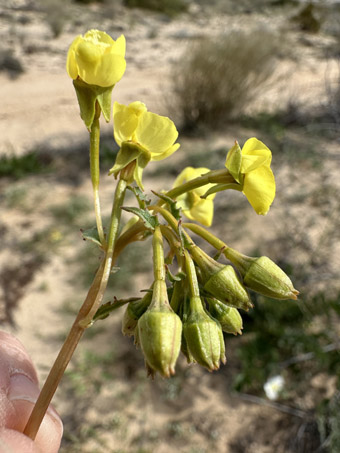
Pierson Sun Cup was in various stages, from tiny sprouts to fully flowering plants. A gorgeous native.
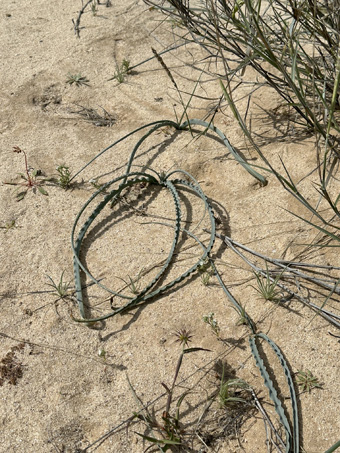
There were so many Desert Lily / Ajo Silvestre (Hesperocallis undulata) sprouting in the dunes. Some were just sprouts.
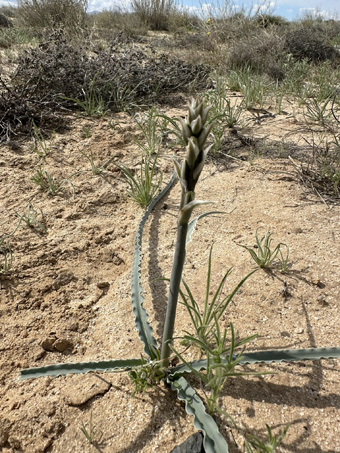
Other Desert Lilies, like this one, already had a flower stalk. See flowers of this species in a previous post from this site in 2021.
At around Km 97 south of PuertecitosI pulled off the road onto an old track to a quarry. The hillsides were spectacular because the Brittlebush had started to bloom in earnest in the five days since we had passed going north, and I really wanted to take some photos.
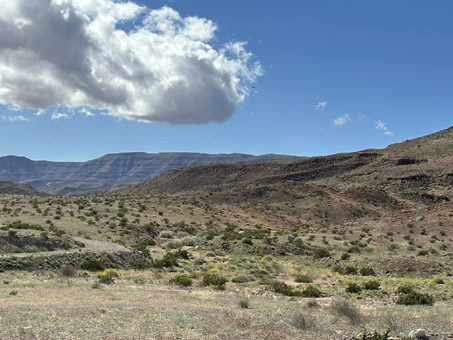
Brittlebush and Creosote Bush (Larrea tridentata) were the dominant shrubs at this spot. It wasn't until I got out of the car that all the herbaceous species became visible against the rocky soil.
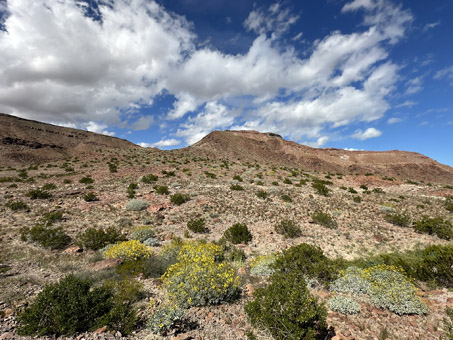
The colors were wonderful with different shades of green found just among the Brittlebush. The Creosote Bush added the dark green spots. The day's cool, damp air softened the usually blinding sunlight.
The site was close to the coast and it was quite gusty, making it challenging to get clear photos. There were numerous species, some pictured below, as well as Desert Drymaria (Drymaria holosteoides var. holesteoides; photos and information here and here), Wooly Plantain (Plantago ovata), Narrow-leaf Cryptantha (Johnstonella angustifolia), and Slimjim Bean (Phaseolus filiformis).
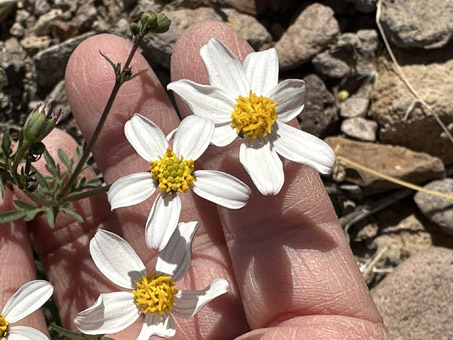
There were many plants of the annual White-Ray Coreocarpus / Aceitilla Blanca (Coreocarpus parthenioides var. parthenioides). This is a widespread, peninsular endemic.
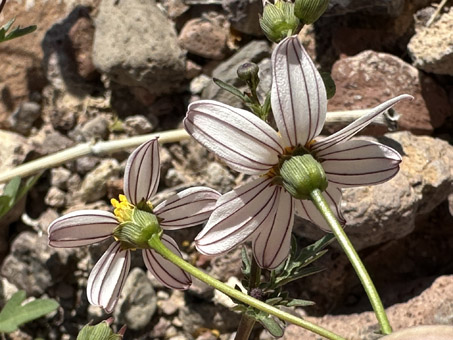
The five fine purplish lines on the back of the ligules of White-Ray Coreocarpus make this species easy to identify on closer inspection. It occurs from San Felipe to the Cape.
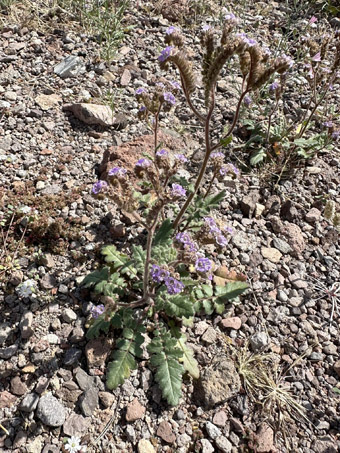
Cleft-Leaf Phacelia / Rama Zorilla (Phacelia crenulata var. minutiflora) is a small, native annual generally ≤ 30 cm H found from around San Felipe to Mulegé.
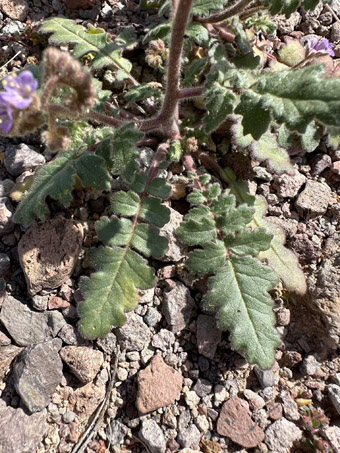
The herbage is pubescent, with both straight and gland-tipped hairs. Leaves are pinnately lobed to dissected.
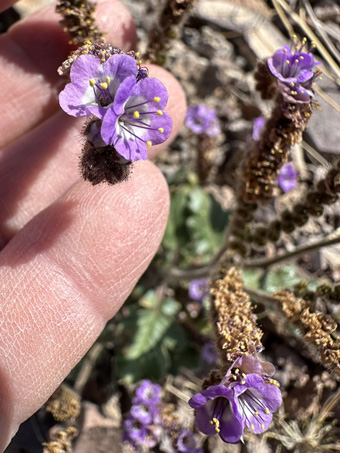
Flowers of Cleft-leaf Phacelia are arranged in a scorpioid cyme that unfurls with age. Corollas are 4-5 mm L with five lobes each 1.1.5 mm L.
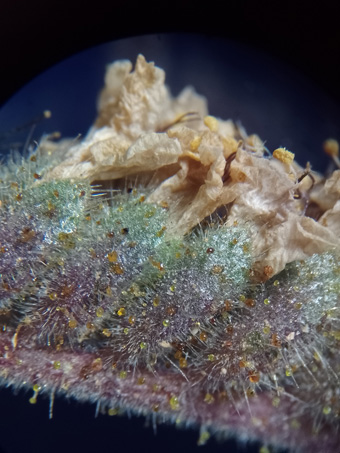
The flowers have very short, stout pedicels and the calyx has short non-glandular hairs and both stalked and sessile glands.
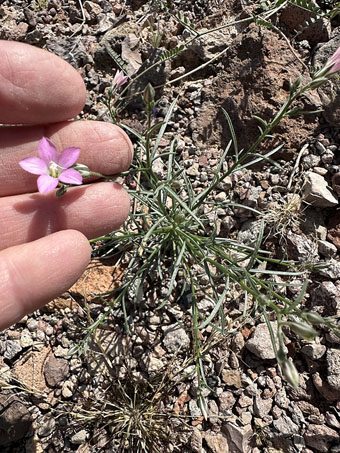
Palmer Bryantiella (Bryantiella palmeri) is a small, endemic annual herb found from around Puertecitos (just north of this location) to around Volcán las Tres Virgenes (V3V).
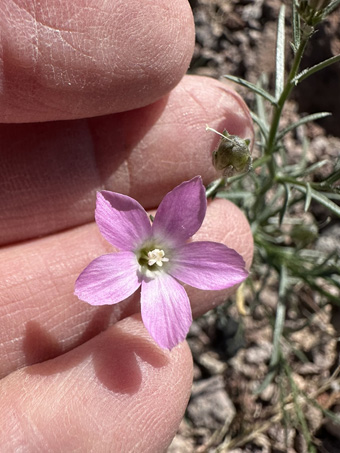
This is the second time I've encountered Bryantiella in this area. A collection that I made of the species near V3V in 2008 turned out to be a record for BCS (first collection for the state). How cool is that?
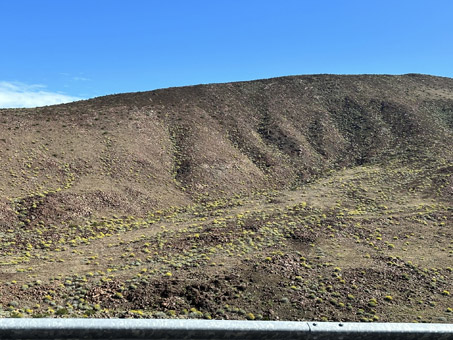
Hillside around Km 97 with all the Brittlebush in flower on this trip.
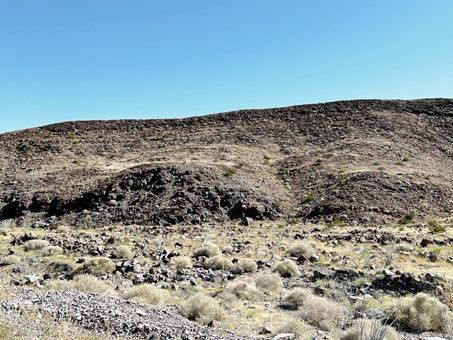
And what the same hill (different angle) looked like in January 2020.
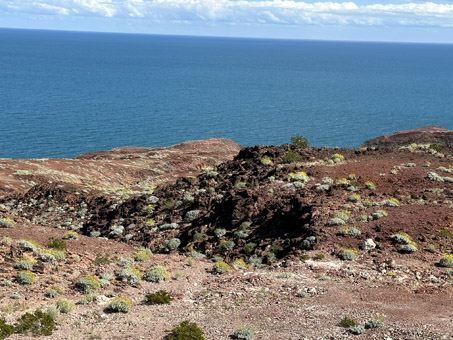
Hillsides at Km 99 vista point with Brittlebush in bloom on this trip.
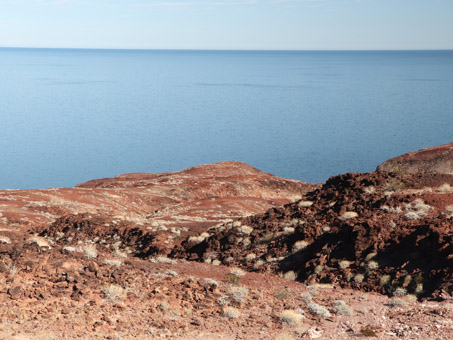
The same hillsides in January 2020.
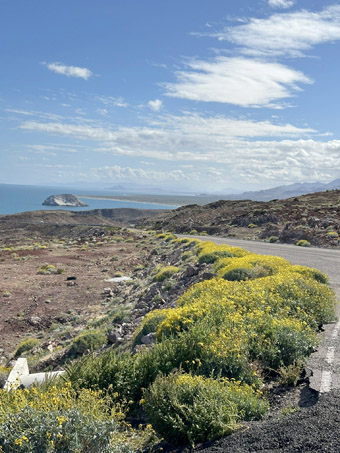
Km 99 vista point this year with Brittlebush in bloom.
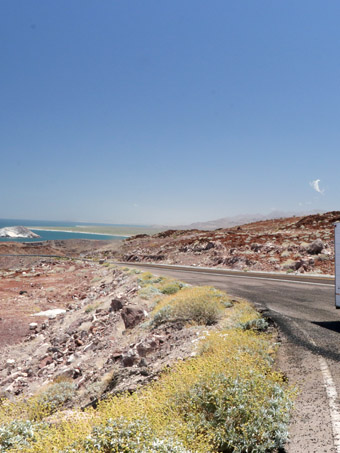
Same view from the vista point in 2020.
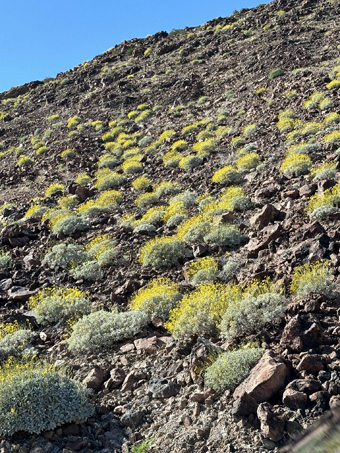
Brittlebush. Catching the sun.
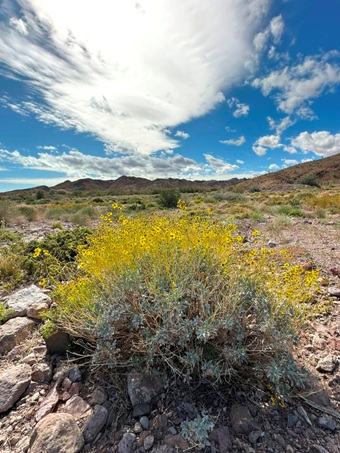
This common and abundant species is stunning.
We made another prolonged stop to look at plants at Km 104 near El Huerfanito, only 20 km south of the fields of Lupine we encountered on our trip north. This was a sandy, silty depression on an alluvial fan (bajada) not far from the road that had been highly disturbed by the highway construction. However, it seemed to be teeming with an abundance of diverse species. This was one of the northernmost spots where the Arizona Lupine could be seen in dense swaths this trip. They mostly petered out going northward, except for a few patches here and there north of Puertecitos.
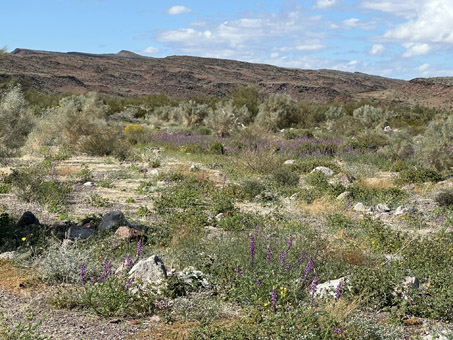
The disturbed area on the bajada near the edge of the highway.
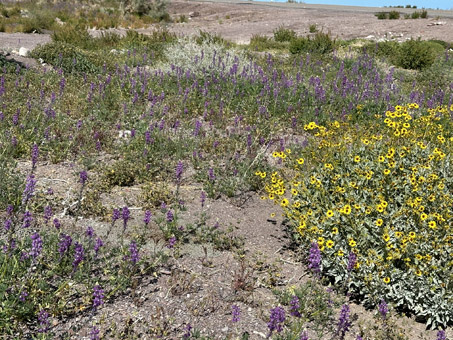
Lupine, Brittlebush and Creosote Bush were the larger plants.
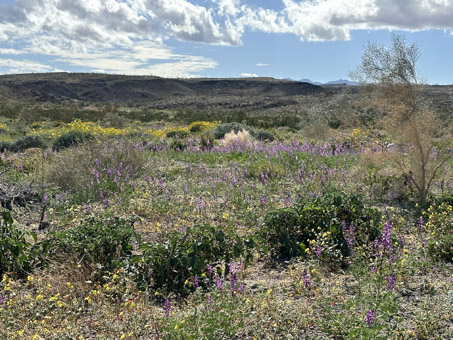
Another view across the alluvial fan towards some low hills. It seemed that with each step or turn, I would find another species.
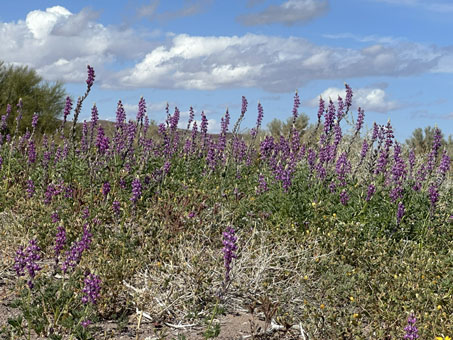
Arizona Lupine, Pegarropa (Mentzelia adhaerens) and Specter Phacelia (Phacelia pedicellata) were among the dominant herbs.
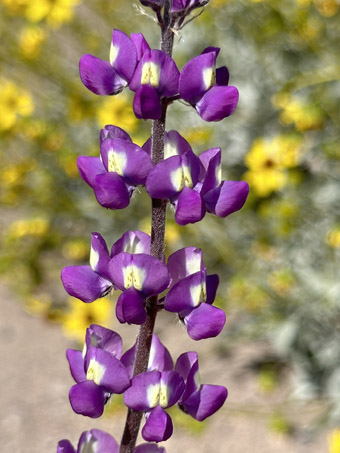
Arizona Lupine is a highly variable annual herb to ±50 cm H. The herbage has both long spreading hairs & short-hairy appressed ones.
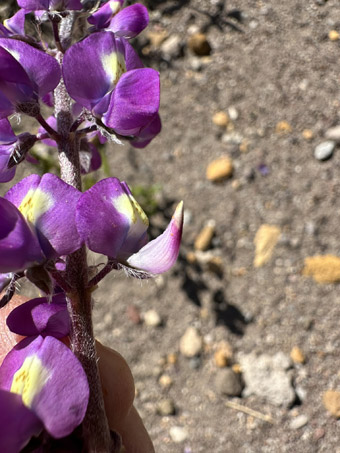
The flower is 7-10 mm L. The wings and banner are dark pink to magenta. The banner has a pale yellow spot with orangish dots and becomes darker with age.
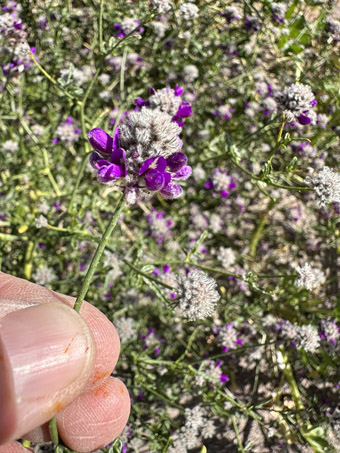
Emory Dye Bush (Psorothamnus emoryi var. emoryi) is a common perennial here. The orange stain on my fingers comes from minute glands on the herbage.
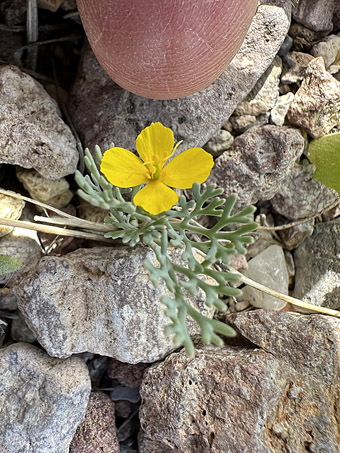
Pygmy Gold-poppy (Eschscholzia minutiflora var. minutiflora) plant in bloom. This is a common native annual reaching 3-8 cm H. Petals are c. 3-8 mm L.
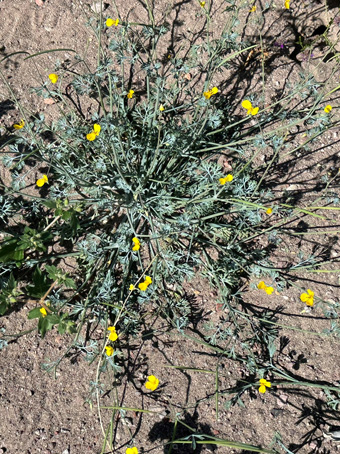
Parish Gold-poppy (Eschscholzia parishii) is a native annual, standing 30-40 cm H. It also occurs in s CA.
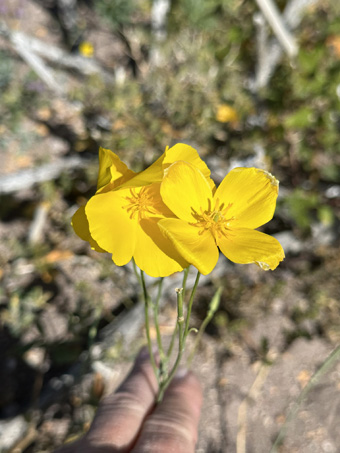
The flowers of Parish Gold-poppy are much larger than the previous species, with petals c. 8-25 cm L.
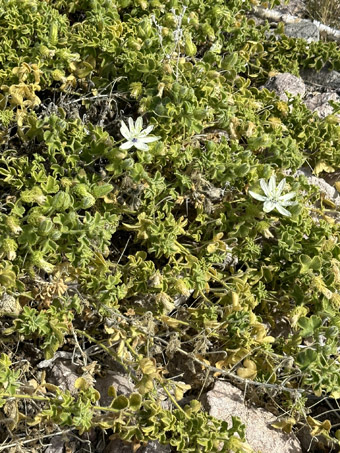
Palmer Passion Flower / Granadilla (Passiflora palmeri) is a near-endemic shrub. More images can be seen in last month's issue.
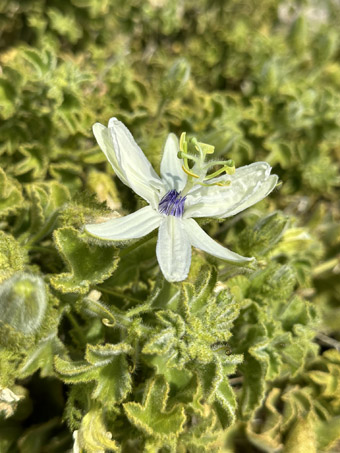
Flowers of Palmer Passion Flower are showy & c. 5 cm D, The species occurs from around Laguna Salada (N of San Felipe, BC) to La Paz (BCS).
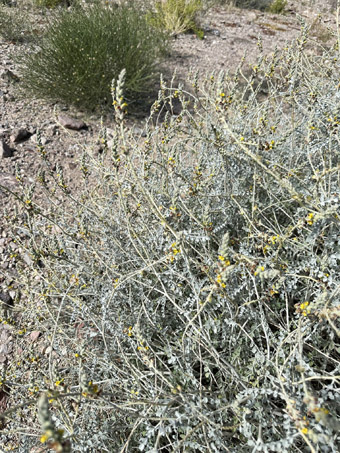
Gulf Dunebroom (Errazurizia megacarpa) is a low shrub that occurs from around Laguna Salada to La Paz along the Gulf Coast. Branches are sparsely covered with golden glands while the inflorescences are densely glandular.
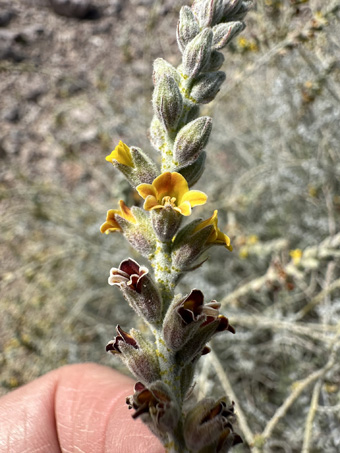
The pinnate leaves are tomentose. Flowers of this leguminous genus are unusual for the family, with four symmetrical petals and a spatulate banner, all somewhat fleshy. Older flowers change color as a signal to pollinators.
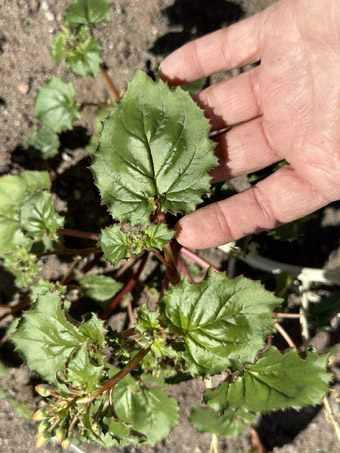
Heart-leaf Sun Cup (Chylismia cardiophylla) is found in the California deserts and along the east coast as far as El Arco.
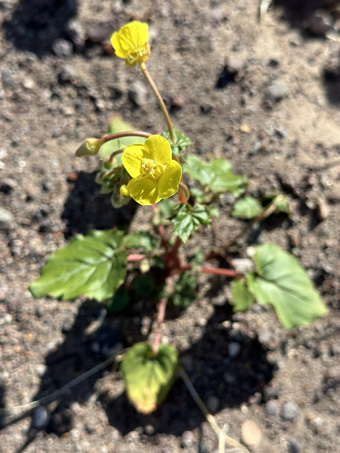
Heart-leaf Sun Cup is a glandular-pubescent native annual. The four petals of are 4.5-12 mm L. The style is 8-23 mm L and has a globose stigma.
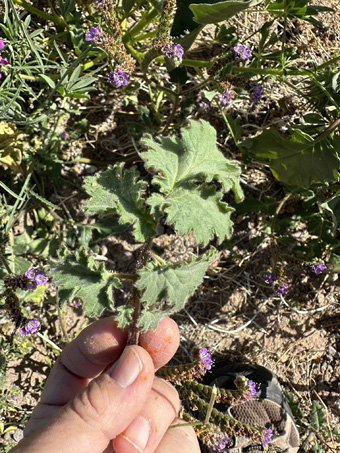
Specter Phacelia / Rama Zorilla (Phacelia pedicellata) occurs from ne BC to around Bahía de los Ángeles.
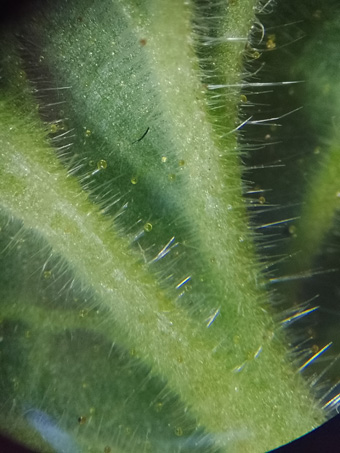
Like many species of Phacelia, Specter Phacelia owes its skunky odor to glandular hairs.
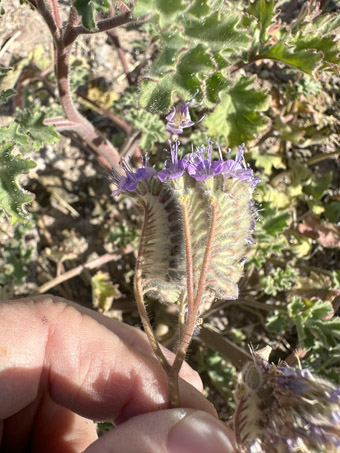
Unlike those of Cleft-leaf Phacelia, the flowers of Specter Phacelia have filiform pedicels to 10 mm L. Corollas c. 4 mm L with exserted stamens & style.
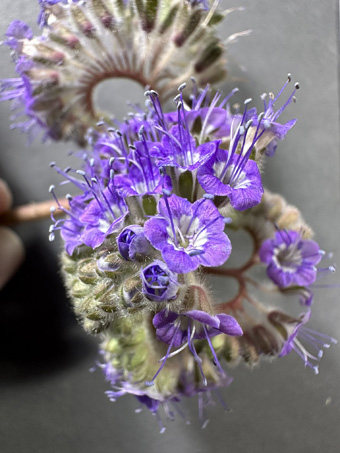
Specter Phacelia occurs along the E side of the peninsula from the Sierra Juárez to the Sierra San Borja. It is also found in AZ, CA and Nevada.
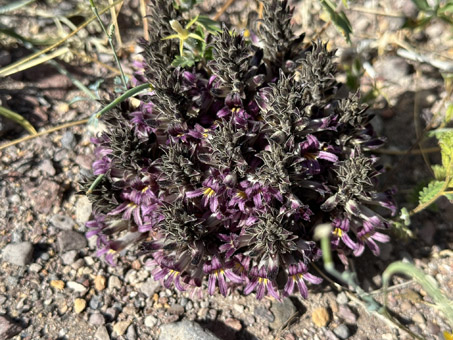
I was pleasantly surprised to find this beauty, Desert Broom-rape / Flor de la Tierra (Aphyllon cooperi) partly hidden by all the new growth in the sandy depression. This native root parasite stood about 8 cm H.
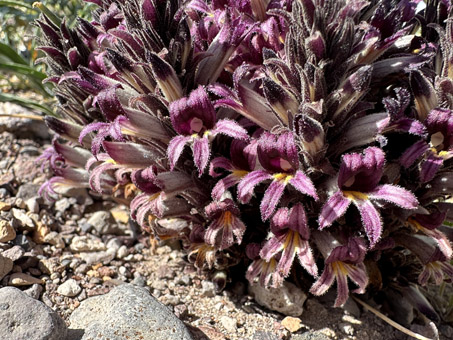
Aphyllon cooperi is parasitic on perennial species in Asteraceae (e.g. Ambrosia, Encelia). Not surprisingly, there were a number of large Brittlebush & Sweetbush (Bebbia juncea var. juncea) nearby.
Unfortunately, we´ve come to the end of this month´s entry. I really wished we could have camped along the way but we weren't prepared for that. It took us about 7 hours to make the 4 hour trip and that was rushing it. And I was torn about moving along, as there was so much more to see and explore in what could be a once-in-a-lifetime opportunity, but concerned about reaching our destination before dark.
We got a late start that morning because of needing to rest up from our late arrival in San Felipe after dark the night before, and I really didn't want to repeat that experience again, especially along the upcoming stretch of highway between Laguna Chapala and Guerrero Negro that was in terrible shape with lots of killer potholes. So, at some point around 2:30 pm, with 3+ hours left to drive, I had to swear to my partner that we wouldn't stop any more except for a quick pit stop and stretch as needed for the rest of the way.
Until the next adventure, hasta pronto...see you soon.
Debra Valov — Curatorial Volunteer
For a full inventory list of this month's plants (family, latin name and common names in both English and Spanish as well as links to photos from previous posts or my iNaturalist observations), visit this page.
For previous entries about this area, see: April 2020, Sep 2020, April 2021, Jul 2021, Aug 2021, Mar 2022, Jul 2023
References and Literature Cited
Rebman, J. P., J. Gibson, and K. Rich, 2016. Annotated checklist of the vascular plants of Baja California, Mexico. Proceedings of the San Diego Society of Natural History, No. 45, 15 November 2016. San Diego Natural History Museum, San Diego, CA. Full text available online.
Rebman, J. P and Roberts, N. C. (2012). Baja California Plant Field Guide. San Diego, CA: Sunbelt Publications. Descriptions and distribution.
Schneider, A.C., & Colwell, A.E.L. (2022). Aphyllon cooperi, in Jepson Flora Project (eds.) Jepson eFlora, Revision 11, https://ucjeps.berkeley.edu/eflora/eflora_display.php?tid=13615, accessed April 10, 2024.
Still, S.M., G. Hannan & C. Curtis 2023. Eschscholzia parishii, in Jepson Flora Project (eds.) Jepson eFlora, Revision 12, https://ucjeps.berkeley.edu/eflora/eflora_display.php?tid=25214, accessed April 09, 2024.
Valov, D. (2020). An Annotated Checklist of the Vascular Plants of Mulegé, Baja California, Mexico. Madroño 67(3), 115-160, (23 December 2020). https://doi.org/10.3120/0024-9637-67.3.115
Walden, G.K., Patterson R.W., Garrison, L.M. & Hansen, D.R. (2023), Phacelia pedicellata, in Jepson Flora Project (eds.) Jepson eFlora, Revision 12, https://ucjeps.berkeley.edu/eflora/eflora_display.php?tid=37539, accessed on April 09, 2024.
Wiggins, I. L. (1980). The Flora of Baja California. Stanford University Press. Keys and descriptions.






